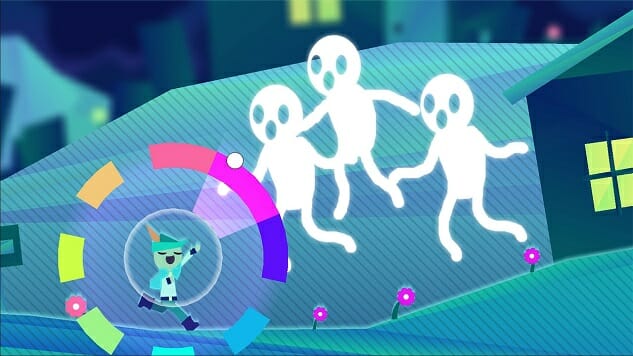Wandersong and Other Independent Games Capture the Spirit of Children’s Storybooks
Games Features Wandersong
When I was a kid, I lived for books. Not just for them, in them. My father, determined to raise a little baby genius, started to teach me how to read when I was 2, and by first grade, I had a high school reading level. I loved everything about books—how the glossy pages felt on my finger tips, how the hardcovers were cool on my bare lap, and how the illustrations on each pages looked so different from the world as I knew it. I borrowed fiercely and often from the kindergarten library, and later, the one for the “big kids” at my elementary school, bringing home stacks by the dozen each week while the librarians smirked from behind their counter, convinced I couldn’t possibly be reading each one.
As I grew older and my parents’ marriage started to fall apart, they turned to Christian fundamentalism and books became, as I’ve put it, a “day pass from Hell.” My mom and dad went through a burning phase, getting rid of all my movies, fantasy books and secular music in one fell swoop, leaving me with little outside of what they’d already approved as non offensive. With my entertainment world around me so limited and my home life so unhappy, I began to disappear behind my books, staying up until 4 AM to reread C.S. Lewis or a Babysitters Club novel, hiding what I wasn’t allowed to have under my pillow or in my desk at school. They weren’t just a place to learn new things or experience new perspectives. They were a place to hide.
Perhaps the best thing about the books I enjoyed in elementary school was their art styles, or rather, how different each one was from the other. From the works of Maurice Sendak to The Very Hungry Caterpillar to Lon Po Po, Mufaro’s Beautiful Daughters, The Talking Eggs or Blueberries for Sal, when I think back to how safe and inspired those old books made me feel, I realize it was the first time I’d learned the world could be so beautiful. The freedom of self expression stirs me to this day.
It feels as though the digital era has created more places where illustrators like those from my childhood can flourish. Over the years, I’ve compared a lot of indie game art styles to children’s picture books, and as the memories of each start to stack up in the library of my own mind, I’ve come to see the deep parallels between my love of the two. Whereas once children’s storybooks might have been among the few places to showcase a distinct but folksy art style, now there are at least a few more outlets, and indie games, where experimental or offbeat visuals often find a home in the absence of risk averse publishing execs and the pressure to focus on combat based gameplay, have been a fertile environment for growth. In some ways it’s not even just the art that found a new home; thoughtful pacing and the simple desire to showcase a slice of human life are right at home in the era of visual novels and “walking simulators.” Games like the breathtaking Gorogoa or the quietly contemplative Lieve Oma embrace the format purely, whereas titles like Carto or Skye reinvent it with their gentle use of puzzles and exploratory creative thinking. In that sense, maybe some games can be an even better way to support the development of verdant young minds, by encouraging them to observe their surroundings in a comprehensive way.
It’s a sentiment I’ve felt the past few days as I’ve played Wandersong, a little music puzzle title I’ve been working through on the Switch. It tells the story of a traveling bard as he sings his way across the land, helping villagers while in pursuit of the magic songs that will bring universal harmony and balance to save the world. The game’s combination of gameplay and narrative is enchanting; to make the bard sing, you must copy the notes (by matching color, but sometimes only by ear) on a rainbow wheel controlled by the right analog stick. In an early level, I directed the growth of plant vines and stems to reach new platforms, and correctly mimicked a bird’s song to be sent aloft over nearby obstacles. The art style, reminiscent of construction paper cut-outs, is cheerful and uncomplicated, the tone of the dialogue impishly informal. It seems like exactly the sort of game I would have loved as a grade schooler.
Recently my niece got into The Lion’s Song, which surprised me, since she’s only 10. I thought a game with so many grownup stories would be too boring for a child. But she actually loved the sepia toned pixel art, the multiple choice scenarios, and feeling as though her choices had an impact on the story. While a videogame could never replace the sensory experience of reading a physical book, neither could reading a physical book ever eclipse the unique narrative advantages of a videogame.
None of this is to say that there aren’t quirky storybook art styles in big game design. But sometimes flipping through the indie games library of my mind feels like browsing a Scholastic Books order form all those years ago. There was kindness in the pages of those books, as if they were written, drawn and painted because the authors wanted us to be happy. And so too is there kindness in the visuals and writing of modern indie games.
Holly Green is the assistant editor of Paste Games and a reporter and semiprofessional photographer. She is also the author of Fry Scores: An Unofficial Guide To Video Game Grub. You can find her work at Gamasutra, Polygon, Unwinnable, and other videogame news publications.